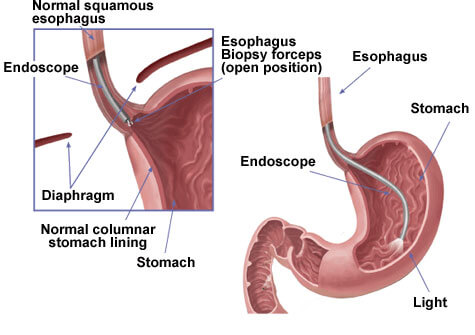

Before the procedure a light anaesthetic (sedative) is usually given – you will not receive a full general anaesthetic. You may be slightly aware of what is going on in the room, but generally you won’t remember anything. The back of your throat may be sprayed with local anaesthetic to make it numb, and a small mouthguard may be put between your teeth to stop you from biting the endoscope. If you have false teeth (dentures) they will be removed before the procedure. The doctor and medical staff monitor your vital signs during the procedure and will attempt to make you as comfortable as possible. The procedure takes about 15 to 30 minutes.
Once sedated and lying in a comfortable position on your left side, the endoscope is passed through the mouth and then in turn through
the oesophagus, stomach and duodenum. The tube is just less than one centimetre in diameter and does not enter your windpipe, so it
won’t interfere with breathing. A small camera in the end of the scope transmits a video image to a monitor, allowing the doctor to
carefully examine the lining of your upper GI tract. 
Gastroscopy is usually performed to evaluate symptoms of indigestion, upper abdominal pain, nausea, vomiting or difficulty swallowing. It is also the best test for finding the cause of bleeding from the upper gastrointestinal (GI) tract. Gastroscopy is more accurate than x-rays to detect inflammation, ulcers or tumours in the upper GI tract. Biopsies (samples of tissue) can be taken to determine sites of infection, to test the functioning of the small bowel and to diagnose abnormal tissue, including conditions such as coeliac disease and cancerous lesions.
Gastroscopy is also used to treat conditions of the upper GI tract. Your doctor can pass small instruments through the endoscope to directly treat many abnormalities with little or no discomfort. For example, your doctor might stretch a narrowed area, remove polyps (usually benign growths) or treat bleeding.

You will be monitored in the recovery area until most of the effects of the sedation medication have worn off.
Your throat might be a little sore, and you might feel bloated because of the air introduced into your tummy.
In most circumstances your doctor will briefly inform you of your test results on the day of the procedure. A follow-up appointment may be made to discuss the test results more fully. The results of any biopsies or samples taken will take several days. Because of the sedation given it is very important that you do not drive a car, travel on public transport alone, operate machinery, sign legal documents or drink alcohol on the same day after the test. It is strongly advised that a friend or relative take you home and stay with you. Full recovery is expected by the next day. Discharge instructions should be carefully read and followed.
.
If you have any of the following symptoms in the hours or days after the gastroscopy you should contact the hospital or your doctor’s rooms
immediately:
• Fever
• Trouble swallowing
• Increasing throat, chest or abdominal pain
• Other symptoms that cause you concern.
Please complete the form below & let us know how we can help you today.